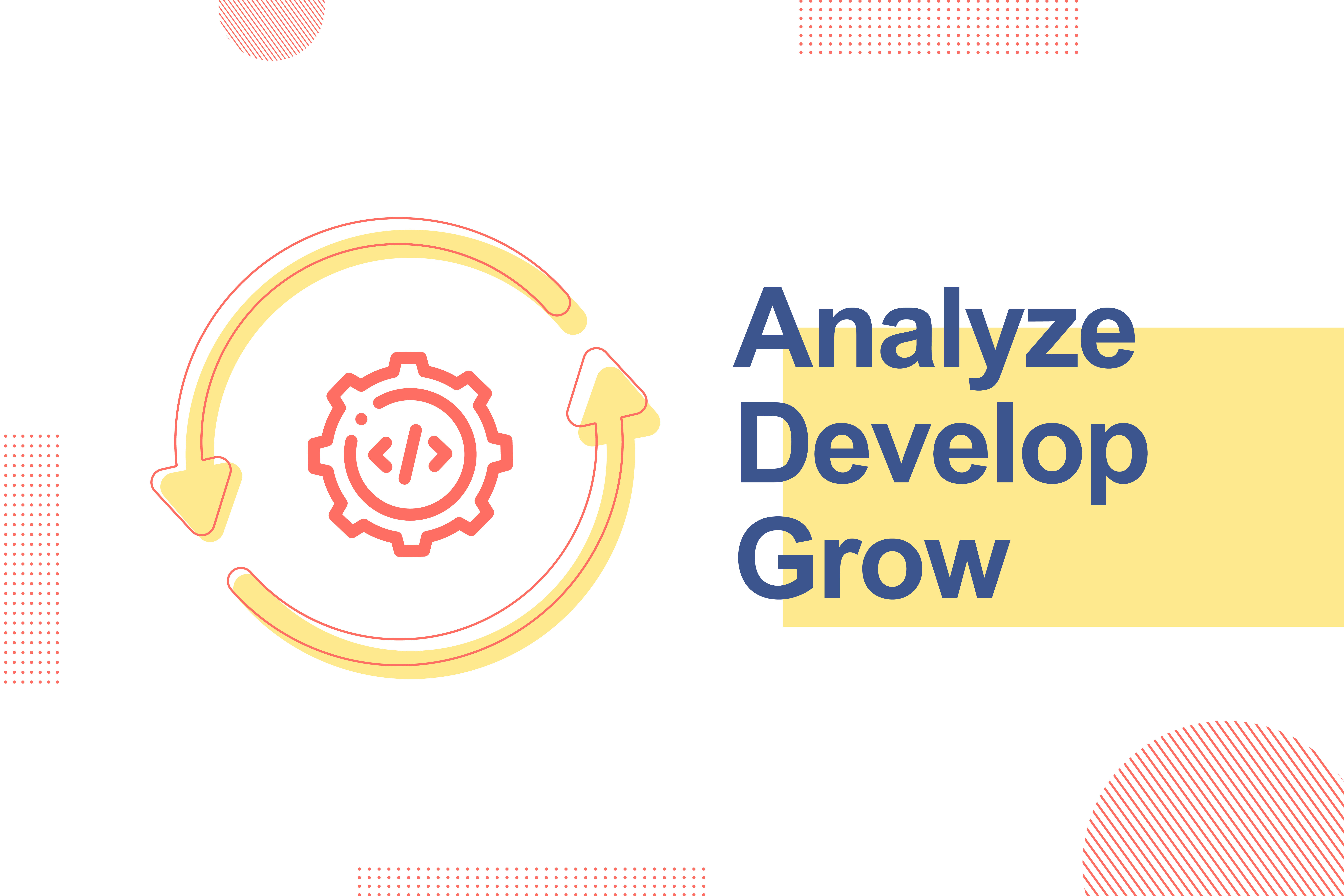So, you want to create a digital product and you’ve researched a bit about the product development lifecycle and the conclusion was that developing a digital product is not an easy thing to do. It involves a lot of structure, planning and knowledge. Only taking the time to scratch the surface of what that involves, can be intimidating.
When building new software, understanding what are the steps during the development process can be very useful. It gives you clarity and reassurance that you know and understand “what’s going on behind the scenes”.
For any good idea to be successfully implemented, you need a good plan. In addition to this, we believe that the implementation and the commitment to stick to it are at least equally important as the idea screening.
Table of Contents
In any product development stage, you should be able to adjust or even pivot if the market requires it. In the software engineering world, the whole development process is referred to as the product development life cycle. The flexibility to adapt is assured by the so-called agile methodology.
A software development life cycle (or simply put SDLC) or product development lifecycle, is a group of very well-defined steps a software agency follows when developing a digital product. Naming might differ from agency to agency, but the logic behind each step is the same.
If you’re thinking of developing custom-made software, and want to better understand how your product comes to life, here are the product development stages and examples you can follow.
1. Analysis
In order to develop the best digital solution for your needs, we first have to understand your business, operations or whatever the new software will be addressing.
During the business analysis introductory stage, we will all get onto the same page. There will be a lot of questions and introspection, so prepare yourself for some in-depth discussions.
We will discuss several aspects of your business, beyond the tool you want to develop, in order to better understand how this new functionality will integrate into your business ecosystem. To bring more clarity, here are some of the topics we will discuss:
- Understand your end goal – why do you want to develop the product, and what is the root cause of your need.
- The current state of your business – we will look into better understanding your business as a whole. What’s its main goal and vision, what’s the overall feel of adoption and using digital solutions and more.
- How do you currently operate – what’s your way of doing things? Do you use a similar tool, and why is it not good enough anymore? What other tools do you use and how? These basic questions will help us better understand what type of functionalities and interactions interest you. It’s an easy way for both parties to understand your needs and expectations.
- Understanding the requirements – from the beginning, we want to make sure we are on the same page when it comes to the essential requirements of the product. Also, this helps us give you an accurate time and cost estimation for your product development.
- Who are the end users of the product – what are their digital skills and how comfortable they are using digital tools in their day-by-day activities? It’s important to know the users’ behaviour in order to develop the friendliest software for them.
- Are there any security concerns? – A product that processes sensitive data needs an appropriate development approach to meet the desired level of security, specific attention and consideration when dealing with other tools’ integrations.
The technical analysis stage is vital to lay a strong foundation for the future development of your product. By the end of it, you will have a clear understanding of what you actually need and how it should work.
2. Software Architecture
With a clear idea in mind, we start to design basic aspects of the desired product: what components are needed and how they should communicate, how the data will be pulled from the database, used and visualised and many other technical aspects.
We often call this the software architecture stage.
A software architect will design how the components and functionalities of the software should work together. By this time, we’ll know exactly what the expected result is, so with that in mind, we’ll basically translate your business needs into technical diagrams.

To give you a more in-depth understanding, here are the things we design and address during this phase:
- Diagrams and data flows – firstly, we need to know how the data is processed and how it flows through the different components, modules and screens of the software.
- System integrations – based on case-specific needs, the new digital product might need to be integrated with certain internal tools. A classic example would be the integration with your organization’s network login system, called Active Directory. We identify what is required to have the app work flawlessly with other tools you use.
- UX/UI mock-ups – our designers sketch wireframe user interfaces to give you and the developers the feeling of the new software concept.
- Use case diagrams – we design how a user would use the software, and how he would navigate through different screens to accomplish specific goals.
- Accessibility – it’s almost the norm nowadays for new software products to be hosted in the cloud, but certain ones must be hosted and accessed internally only, for security reasons. Each type of accessibility needs different development approaches. At this point, we also design user roles and accessibility levels of the app.
- Security – security is a big topic in the digital world. Building secure apps is more important than ever. We design the levels of security needed, as we discussed during the analysis phase, and plan the required tests to be performed: internal security audits, and external penetration tests.
You can think of this stage as the very first draft of your product. You’ll get to see basic sketches of your desired product and from here we’ll start the actual development.
3. Planning
In this product life stage, we will make a detailed list with all the functionalities needed and we will set clear expectations about how the development process will look from now on.
This stage in the product development process will often involve face-to-face meetings, setting milestones, KPIs and categorising activities based on priorities and more.

While the planning is mostly project management, rather than coding and developing a product, you should be involved in the project planning alongside our dedicated team. This is the part where you can understand how and what steps will be taken in order to develop your product.
You will get clarity and reassurance that your product is in the right hands, and it’s in line with your expectations, delivery schedule and budget.
There are some other details that go behind the scene on our side too. We assign a dedicated project manager and product team to work on the project, giving them the details and establishing a working plan.
We know each team member’s affinities in terms of development and we always try to match a project with our colleagues’ passions and technical expertise.
However, developing digital products is part of a learning curve and growth stage for every product development team as each product idea brings something new to the table.
4. Development
The development phase is probably what most people think of when they want to develop a digital product. This is where the “action” happens and while this is the longest stage of them all, you’ll see that the actual coding is just a part of bringing the product to life.
In many cases, the development stage is split into two or three phases, depending on the software complexity and the go-to-market strategies:
- Prototype – prototyping is an important step because we use this to sketch a basic first draft of your desired product. Designing a prototype does not require a lot of resources, but it helps us start on the right foot, with your clear needs in mind.
- Minimum Viable Product (MVP) – we usually encourage people to initially develop an MVP. An MVP has basic functionalities only – the ones that are most important and actually help with your problem. We encourage starting with an MVP first. An MVP can be used and tested right away, thus getting valuable feedback straight from the users. In this way, you will discover how users use the application and what they really need for further development.
- Full product – your final product with all the bells and whistles.
As most modern software agencies, we use the Agile methodology to develop products. We adopted the Agile methodology before even knowing it was an actual thing. We are always asking our clients to test and provide recurrent feedback for our development. This approach brings fast results at the highest quality and offers our clients more control over what is getting developed.
Another big advantage of the Agile approach is the sprint work structure.
Sprints are basically checkpoints or milestones broken into small goals, translated in development iterations, usually lasting for two weeks.
These are the steps we follow during the development of a product:
- Planning – based on our analysis and discussions, we set which functionalities can be built in the next two weeks
- UX/UI Design – a designer takes care of the look of the app, and checks with you for further tweaks to match your vision and expectations
- Coding – this is the part we most often hear of: a team of software engineers work on coding the functionalities, look and feel of the software – we integrate the proposed architecture and design, connect it to a database and other tools needed, test the code and more
- Quality Assurance Testing – the quality assurance stage gives us the reassurance that the newly developed functionalities work as expected. A quality assurance engineer can perform both manual and automatic tests. If issues are found, the functionality will be returned to a software engineer, who will fix it accordingly.
- Reviews – this is the step where you come in! Every two weeks, you will get to see and interact with a new part of your future product. Keep in mind that this is the perfect time to be the harshest critic, everything should look or work exactly as you envisioned.
We will repeat these steps until all the iterations are completed, and the final digital product is ready to go live.
That’s why agile development is so appreciated: it’s efficient, transparent, and easily adaptable.
5. Launch
The big day everyone has been looking forward to is here: the launch day!
In order to have the app fully functional outside our testing and developing environments, a DevOps engineer will set up the infrastructure and make sure all new functionalities get to you fast and safely.

This should be the last “waiting” step you’ll have to go through. Now you have a fully functional digital product that is built and designed with your particular needs and wishes in mind. It’s time for you or your clients to enjoy using it!
6. Maintenance
Typically, a digital product is not a one-time effort. And although maintenance is sometimes excluded from the list of product life cycles, it should be viewed as a very important step if you plan to use your product in the long term.
Technologies constantly evolve and your tool or product needs to keep up with these changes. Also, not to mention that your business will evolve as well. You may discover you need more functionalities or improvements as your team grows, or hopefully, you may just encounter new business opportunities that would add up to the existing technology you built.
In the end, being agile and keeping an eye on technology advancements is what will make your business save more time, make more money and keep your team at its highest performance possible.
Conclusion
The product development lifecycle process is quite complex. And as you already saw, the actual coding is just a portion of the entire process you should be paying attention to.
In order to develop a successful digital product, you need to consider various aspects such as research, analysis, efficiently communicate with your software developers and last, but not least, to understand what goes behind the entire development process.
It’s important for you to know all these, and it’s also our responsibility as a software development provider to make the process transparent and put you in control.
We hope that our in-depth guide brought more clarity on how a software product comes to life and that now you know what you have to do next.
Are you ready to upgrade your business process? Let’s talk!





